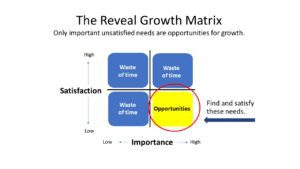3 Steps to Change the Game of Innovation
New product failure rates have remained stubbornly high for decades at about 70-90%. Most people believe this is because innovation is inherently risky and messy. As one innovation “expert” stated in a leading business journal recently:
“Innovation is a process of trying your best ideas and seeing what happens. Then, based on what you’ve learned, you can adapt what you do next. The whole process is inherently unpredictable, and as a result, disappointment and frustration often set in when things don’t go as planned.”
This is the calamitous path many companies are following because they have been sold bad theory and false beliefs. While testing your best ideas and seeing what happens is part of innovation, it goes much better when you have already validated the customers’ needs so that you are testing only the solution’s efficacy. Would you like your doctor to test their best ideas on you without first confirming the diagnosis? I don’t think so. Most customers don’t like it either.
After 20 years of helping companies innovate and grow, I have found and studies have confirmed1, that the primary reason for high failure rates is misunderstanding the target customers’ needs, not the nature of innovation itself. I have seen this hundreds of times and it still pains me because it doesn’t have to be that way.
Virtually any organization that knows what type of customer information to obtain, how to get it, and how to use it, can flip the script, change the game, and achieve dramatically better results. Reveal Growth Consultants has a process to help companies do that. Here are three steps to change the game.
1) Find the opportunities in your market
An opportunity is a customer need that is both highly important and poorly satisfied. The more important and less satisfied a need is, the greater the opportunity for innovation and growth it presents.
The jobs-to-be-done (JTBD) innovation framework defines “customer needs” as the functional, emotional, and social jobs that customers want to get done and the criteria they use to measure success. A key feature of customer jobs and criteria is that they are separate and distinct from product or service solutions.
Remember, “People don’t want to buy a ¼” drill; they want a ¼” hole!” Customer needs are separate and distinct from product and service solutions. If we can keep this distinction in mind, then we can obtain a comprehensive set of customer needs — i.e., jobs and criteria — in virtually any market totally independent of any current products or services.
Further, by capturing customer needs as jobs and criteria statements (for example, Make a ¼” hole is a job statement and Minimize the likelihood of making a hole in the wrong location is a criterion statement), organizations can determine which needs are highly important and poorly satisfied, i.e., which are opportunities. This is done by deploying a web-based survey to a representative sample of the target market to obtain customer ratings for importance and satisfaction on every need statement. This enables companies to identify and rank the biggest opportunities in the market from the customers point of view with statistical validity.

2) Determine which opportunities to pursue
Evaluate each market opportunity with your own criteria such as your mission, strategy, relative competitive advantage, revenue opportunity, etc. Part of your evaluation should answer the question, “What is the best way to address this market opportunity?” It’s not always by creating new or improved offerings. Sometimes, a better way is through internal operational alignment, a merger or acquisition, a partnership, or simply by creating better messaging and positioning that speaks to the customers unmet needs.
3) Focus your creativity on only the best opportunities
The “best” opportunities are pre-validated market opportunities that you can address and capture successfully. By focusing on only the best opportunities, you can be sure you’re creating unique value for your customers, and competitive advantage for your organization. Knowing where to focus your creativity makes all the difference in the world.
Innovation should never be a guessing game. You deserve to know exactly what your target customers want before you start generating solution ideas. Customers can tell us what they want if we ask them what they want to accomplish rather than asking them for product or service specifications.
Stephen Covey taught us that the first two habits of highly effective people are, 1) Be proactive, and 2) Start with the end in mind. These principles have stood the test of time and, when applied to innovation, yield highly effective innovation teams.
Be proactive and discover your target customers’ ends-in-mind (i.e., the jobs they want to get done, the criteria they use to measure success, and where they struggle in a specific circumstance). Then, as with any project, the rest will go a lot better. You really can turn innovation and growth into a repeatable business process that consistently delivers results if you know how to reveal the target customers unmet needs.
Reveal needs. Create value. Drive growth.
Footnote 1:
Robert G. Cooper, Co-founder of the Stage-Gate Idea-to-Launch Process, who has done some of the most extensive research on why new products fail has repeatedly found that the number one cause for new product/service failure is misunderstanding the customers’ needs and the competitive situation, i.e., the front end of innovation.
“A thorough understanding of customers’ needs and wants, the competitive situation, and the nature of the market, is an essential component of new product success. This tenet is supported by virtually every study of product success factors…Sadly, a strong market orientation is missing in the majority of firms’ new product projects. Successful firms spend about twice as much time and money as unsuccessful firms on these vital front-end activities…Research shows that homework pays for itself in improved success rates and actually reduces development times.”
The Drivers of Success in New-Product Development, Industrial Marketing Management 76, (2019) 36-47.
We help smart executives clarity where to focus and what to do to drive innovation and growth. Schedule free exploratory call here.




